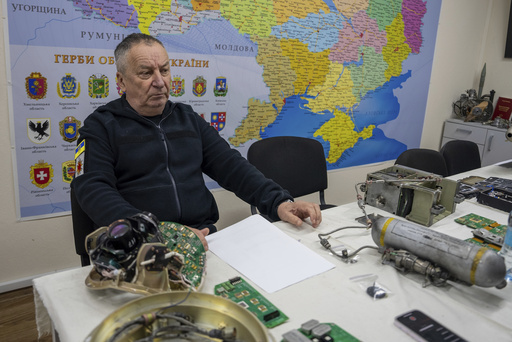
In the hidden depths of a manufacturing facility located in Russia’s central plains, engineers are producing a significant number of decoy drones designed to bypass Ukrainian defenses against a terrifying new arsenal of weaponry. The facility, situated within Russia’s Alabuga Special Economic Zone, has recently begun producing thermobaric drones alongside these decoys, which are alarming new threats discovered through investigative reporting.
Designed to generate a devastating high-pressure vortex, thermobaric warheads can breach substantial structures. They are notorious for their capability to eliminate all oxygen in their vicinity and inflict serious injuries even far from the direct blast zone, including ruptured lungs and severe brain damage. The strategy to deploy decoys was reportedly initiated by Russia in late 2022 under the codename Operation False Target. According to a source who requested anonymity due to the sensitive nature of military operations, the concept involves launching drones alongside numerous decoys—some filled with simple materials like rags or foam—which appear indistinguishable from actual explosive-laden drones on radar.
The aim of this strategy is to create confusion for Ukrainian forces, forcing them to make quick decisions on how to allocate their limited resources, all while trying to safeguard lives and preserve vital infrastructure. Aiming to evoke uncertainty in the enemy, one official explained that the challenge is for Ukrainian troops to discern whether they face a lethal threat or merely an imitation drone. Moreover, with the inclusion of thermobaric warheads, there’s an increased risk that armed drones could stray from their intended course and strike civilian areas, potentially causing catastrophic damage.
In recent times, Ukraine has seen a surge of decoy drones filling its airspace, each one presenting as just another blip on military radar systems. For instance, during the first weekend of November, the Kyiv region endured 20 hours under air alert, with buzzing drones accompanied by the sounds of air defense systems engaging. Reports indicate that unarmed decoys constitute over half of the drones targeting Ukrainian locations, as noted by a drone surveillance expert in Ukraine. Both armed drones and their decoys are produced at the Alabuga factory, which has expanded significantly since the onset of the conflict in Ukraine, transitioning into military production facilities.
Initially created to attract business investment in Tatarstan, the Alabuga zone’s intent has shifted to primarily manufacturing drones for the Russian military. Despite promotions depicting the hub as an innovative enterprise, scrutiny revealed troubling conditions, including accusations against the factory for misleading individuals—particularly African women—into accepting roles there under false pretenses.
In 2022, a $1.7 billion deal was struck between Russia and Iran for the production of Shahid drones. Following this agreement, the Alabuga factory commenced drone manufacturing, and since then, the number of drone attacks surged. Recent data shows that in October alone, Moscow launched approximately 1,889 drones, a significant increase from earlier months. With the election of Donald Trump having raised concerns regarding continued U.S. support for Ukraine, such attacks intensify fears about the future of assistance.
Despite many drones being intercepted or shot down, a few often manage to evade defenses, resulting in grave consequences for Ukrainian civilians and infrastructure. Nightly swarms of drones have created an atmosphere of panic and fatigue among the population, leading to evolving tactics from Russian forces. Alongside drones, powerful missiles target defenses, making the situation increasingly dangerous.
Decoys, packed with live-feed cameras, conduct reconnaissance missions, assisting Russia in locating Ukraine’s defenses. Meanwhile, dedicated Ukrainian sharpshooters are on alert, utilizing portable surface-to-air missiles to counteract these aerial threats. One sharpshooter, identified by the call-sign Rosmaryn, described the anxiety that accompanies his duty, likening his adversary to an intelligent entity seeking to evade his team. He shared that identifying the type of drone only occurs after engagement, highlighting the unpredictable dynamics of this aerial warfare.
Some drones reach operational altitudes of 2,000 to 3,000 meters before descending for their final approach. Unbeknownst to many, even basic drones employed in these operations come equipped with sophisticated machinery and components sourced from both China and the West, suggesting that the sanctions imposed have not entirely stifled Russia’s access to vital technology.
Ukrainian President Volodymyr Zelenskyy emphasized that many munitions, including Iranian-made Shahid drones, were possible due to Western technology making its way through sanctions—a situation that American, European, and Ukrainian audiences must confront. The production dynamics at the Alabuga factory are now generating daily dozens of unarmed decoys and a smaller number of armed units, effectively allowing the military to conserve resources while taxing Ukrainian defenses.
As Russian strategies develop, the combination of decoy and armed drones continues to push the limits of Ukrainian military capacity. The introduction of thermobaric weaponry introduces fresh fears, particularly due to its ability to wreak havoc on fortified structures and densely populated buildings. Experts note that the lethal impact of these weapons extends beyond the immediate blast zone, generating massive psychological fear within civilian populations.
In summary, the complexities of drone warfare and the introduction of advanced weaponry are reshaping the battlefield environment in Ukraine, leading to profound uncertainties and dangers as each side adjusts tactics in this ongoing conflict.
